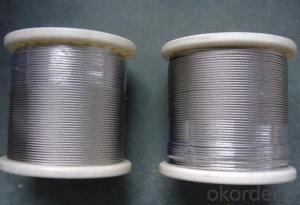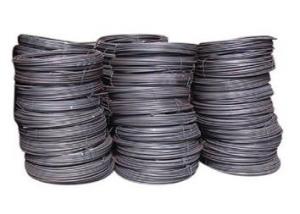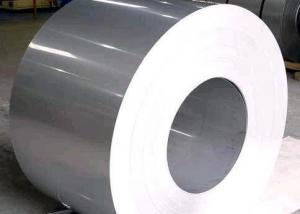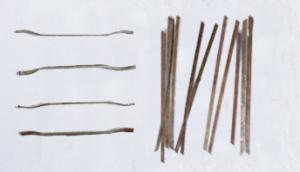Wire Galvanized Carbob Steel Wire for ACSR
- Loading Port:
- Dalian
- Payment Terms:
- TT OR LC
- Min Order Qty:
- 5 m.t.
- Supply Capability:
- 10000 m.t./month
OKorder Service Pledge
OKorder Financial Service
You Might Also Like
Item specifice
Wire Galvanized Carbob Steel Wire for ACSR
Quick Details
Steel Grade: | steel | Standard: | AISI, ASTM, BS, DIN, GB, JIS | Wire Gauge: | 1.24-5.50mm |
Place of Origin: | China (Mainland) | Type: | Galvanized | Application: | Manufacturing |
Alloy Or Not: | Non-alloy | Special Use: | Cold Heading Steel | Model Number: | wire galvanized steel for acsr |
Brand Name: | CNBM | wire galvanized: | wire galvanized steel for acsr |
Packaging & Delivery
Packaging Details: | Coil with plastic outside or according to customer's requirement. |
Delivery Detail: | 20 working days after receiving your order. |
Wire Galvanized Steel for ACSR
1. Material: Q195,Q235,45#,60#,65#,70#,72B,80#,82B,65Mn
2. Surface Coating: Galvanized
3. Characteristic: High tensile strength,small tolerance
Shiny surface, good corrosion prevention
4. Packing type:Spool or Coil
5. Application: Being used for stranded conductors in overhead power circuitry
6. Remarks during use and handling:
a. During transportation, handle softly and carefully, avoid bumping and damaging the steel wires. Moisture and rain prohibited. Steel wires must be stored in dry and well ventilated indoors
b. Pay attention to the direction of steel wires when paying-off. Be sure the spool or coil is rotating freely as to achieve identical tension of all the steel wires
c. In case of batch usage, the remaining should be repacked to avoid oxidizing of the surface
Technical parameters
Wire dia: 1.24-5.5mm; Tensile Strength:1290~1340Mpa
Nominal diameter (mm) | Tensile Strength | Stress at 1% Elongation | Twist | Elongation | Standard |
mm | Mpa | Mpa | Times/360° | Lo=250mm | |
1.24~2.25 | ≥1340 | ≥1170 | ≥18 | ≥3.0% | As per GB,EN,IEC,JIS,ASTM standard, as well as customer's request |
2.25~2.75 | ≥1310 | ≥1140 | ≥16 | ≥3.0% | |
2.75~3.00 | ≥1310 | ≥1140 | ≥16 | ≥3.5% | |
3.00~3.50 | ≥1290 | ≥1100 | ≥14 | ≥3.5% | |
3.50~4.25 | ≥1290 | ≥1100 | ≥12 | ≥4.0% | |
4.25~4.75 | ≥1290 | ≥1100 | ≥12 | ≥4.0% | |
4.75~5.50 | ≥1290 | ≥1100 | ≥12 | ≥4.0% |
NOTE:Providing engineer design as per cstomer's request.
Picture
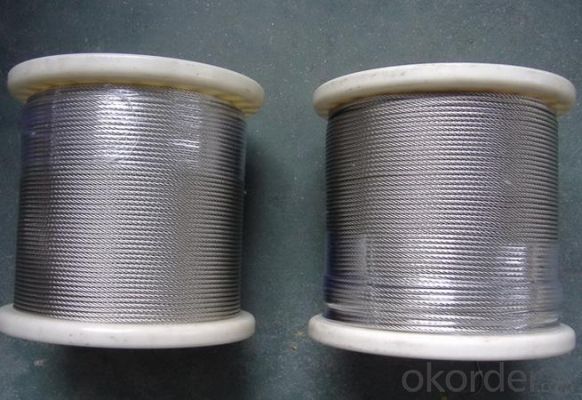
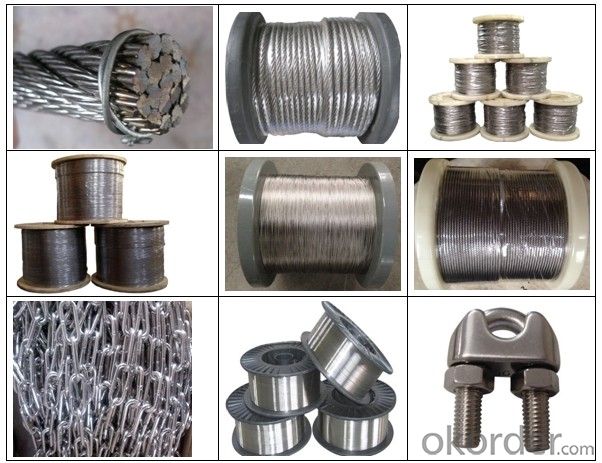
- Q:Can stainless steel wire be used for wire jewelry?
- Yes, stainless steel wire can be used for wire jewelry. Stainless steel wire is a durable and strong material that is resistant to rust, tarnish, and corrosion. It is commonly used in making wire jewelry such as necklaces, bracelets, and earrings. Stainless steel wire also comes in a variety of thicknesses and finishes, allowing for different design options. It can be easily shaped, bent, and manipulated to create intricate wire designs. Additionally, stainless steel wire is hypoallergenic, making it a suitable choice for people with sensitive skin or metal allergies. Overall, stainless steel wire is a popular and versatile material for creating beautiful and long-lasting wire jewelry pieces.
- Q:What are the different types of stainless steel wire rope terminations available?
- There are several types of stainless steel wire rope terminations available, including swage fittings, hand-crimped fittings, mechanical fittings, and wire rope clips. Each termination method has its own advantages and suitability for different applications, ensuring secure and reliable connections in various industries such as marine, construction, and aerospace.
- Q:Can stainless steel wire be used for wire stripping?
- Yes, stainless steel wire can be used for wire stripping.
- Q:How does stainless steel wire perform in corrosive atmospheres?
- Stainless steel wire is highly resistant to corrosion in various atmospheres, including corrosive environments. This is primarily due to the presence of chromium, which forms a protective passive layer on the surface of the wire. This passive layer acts as a barrier, preventing the wire from coming into direct contact with the corrosive elements present in the atmosphere. In corrosive atmospheres, such as those containing high levels of salt, moisture, or chemicals, stainless steel wire demonstrates exceptional performance. It resists oxidation, rusting, and general degradation, ensuring its longevity and reliability in such harsh conditions. This makes stainless steel wire an ideal choice for applications where corrosion resistance is a critical requirement. Moreover, stainless steel wire retains its mechanical strength and integrity even in corrosive atmospheres. It maintains its physical properties, including tensile strength and flexibility, which are essential for its intended applications. This durability ensures that the wire can withstand the corrosive elements without compromising its performance or structural integrity. Overall, stainless steel wire is highly recommended for use in corrosive atmospheres due to its exceptional corrosion resistance, durability, and ability to maintain its mechanical properties. Its performance in such environments makes it a reliable choice for various industries, including marine, chemical processing, oil and gas, and many others.
- Q:What does "80 wire" stainless steel plate mean? How much more expensive than the average stainless steel sheet?
- 80 silk is 0.8MM thick stainless steel plate, the price is almost the same
- Q:What are the different types of stainless steel wire springs for automotive applications?
- Automotive applications utilize various stainless steel wire springs, including compression springs, extension springs, torsion springs, and constant force springs. The most commonly utilized spring type in automotive applications is the compression spring. It is designed to resist compression and deliver a pushing or compressing force. Suspension systems, valve systems, and clutch systems often employ compression springs. In contrast, extension springs resist stretching or pulling forces. They find common usage in automotive applications like seat belts, door handles, and retractable antennas. Torsion springs exert twisting or rotational forces and are commonly found in trunk lids, hoods, and throttle systems. Constant force springs, a subtype of extension springs, offer a consistent force throughout their deflection range. They are frequently employed in automotive applications requiring a constant force, such as windshield wiper systems and automatic seatbelt retractors. These stainless steel wire springs are chosen for their durability, corrosion resistance, and ability to withstand high temperatures and harsh automotive environments. Moreover, the high strength-to-weight ratio of stainless steel wire springs ensures efficient and reliable performance in various automotive components.
- Q:What are the different types of stainless steel wire rope clips?
- Various types of stainless steel wire rope clips are available on the market, including standard wire rope clips, u-bolt wire rope clips, and saddle wire rope clips. 1. Standard wire rope clips are the most commonly utilized type. They comprise a saddle, a u-bolt, and two nuts. The wire rope is placed under the saddle, the u-bolt is threaded through the saddle's holes and around the wire rope, and the nuts are tightened to secure the wire rope firmly. 2. U-bolt wire rope clips, on the other hand, feature a u-shaped bolt that is threaded through the saddle's holes and around the wire rope. They are particularly suitable for applications that require a higher load capacity as they provide a more secure grip. 3. Saddle wire rope clips solely consist of a saddle and two nuts, without a u-bolt. The nuts are directly threaded onto the saddle's threaded ends. These clips are commonly used when the wire rope needs to be tightly secured and when the load capacity is not as high as that of u-bolt wire rope clips. It is worth noting that the stainless steel type used in the construction of these wire rope clips can also vary. 304 and 316 stainless steel are commonly utilized, with 316 stainless steel being more resistant to corrosion and suitable for marine environments or applications involving harsh chemicals.
- Q:What are the different types of stainless steel wire cables?
- There is a wide variety of stainless steel wire cables to choose from, each specifically designed for different applications and industries. Some of the most commonly used types include: 1. 1x7 Construction: This cable is made up of one central wire strand surrounded by six outer strands. It is primarily used in applications that require moderate flexibility and high tensile strength, like cable railing systems and garage door cables. 2. 7x7 Construction: This cable consists of seven strands, each consisting of seven wires. It offers greater flexibility compared to the 1x7 construction, making it suitable for hanging signs, trellises, and general-purpose cable installations. 3. 1x19 Construction: This cable has one central strand surrounded by 19 outer strands, each made up of one wire. It provides excellent strength and minimal stretch, making it ideal for applications that require high tensile strength and minimal flexibility, such as structural support cables and suspension bridge cables. 4. 7x19 Construction: Similar to the 1x19 construction, this cable consists of seven strands, each consisting of 19 wires. It offers improved flexibility compared to the 1x19 construction, making it suitable for marine rigging, zip lines, and overhead crane cables. 5. 7x19 Vinyl Coated Construction: This cable is similar to the 7x19 construction but is coated with vinyl for additional protection against corrosion and abrasion. It is commonly used in outdoor applications and environments where exposure to moisture and harsh conditions is expected. 6. 7x7 Nylon Coated Construction: This cable features a nylon coating that provides extra protection against abrasion and wear. It is commonly used in applications where the cable needs to slide or move through various surfaces without causing damage, such as gym equipment and garage door pulley systems. These examples represent just a fraction of the stainless steel wire cables available in the market. It is crucial to choose the appropriate type based on the specific requirements of your application to ensure optimal performance and durability.
- Q:Is stainless steel wire suitable for wire EDM machining?
- Yes, stainless steel wire is suitable for wire EDM machining. Wire electrical discharge machining (EDM) is a process that uses a thin, electrically conductive wire to cut materials with precision. Stainless steel wire is commonly used in wire EDM machining due to its excellent electrical conductivity and high tensile strength. Stainless steel wire offers several advantages for wire EDM machining. Firstly, it has a high melting point, which allows it to withstand the intense heat generated during the EDM process. This makes it suitable for machining materials with high hardness, such as tool steels or hardened alloys. Additionally, stainless steel wire has good corrosion resistance, which ensures its durability and longevity during the machining process. It also exhibits excellent dimensional stability, meaning that it maintains its shape and size even under high tension. This is crucial for achieving accurate and precise cuts in the machining process. Furthermore, stainless steel wire is available in various grades, each with its own unique properties. This allows for flexibility in selecting the appropriate stainless steel wire for specific machining requirements. For example, some grades of stainless steel wire offer improved machinability or higher tensile strength, making them suitable for different applications. In summary, stainless steel wire is a suitable choice for wire EDM machining due to its excellent electrical conductivity, high melting point, corrosion resistance, dimensional stability, and variety of available grades. It enables precise and accurate cutting of various materials, making it a valuable tool in the manufacturing industry.
- Q:Can 440C stainless steel wire make cold bending slingshot?
- Spring steel has excellent comprehensive properties, such as mechanical properties (especially the elastic limit and ultimate strength, yield ratio), ballistic performance reduction (i.e. anti sagging performance, also known as anti relaxation properties), fatigue performance, hardenability, physical and chemical properties (heat resistance, low temperature resistance, oxidation resistance and corrosion resistance etc.). To meet the above performance requirements, spring steel has excellent metallurgical quality (high purity and uniformity), good surface quality (strict control of surface defects and decarburization), accurate shape and size.
1. Manufacturer Overview |
|
|---|---|
| Location | |
| Year Established | |
| Annual Output Value | |
| Main Markets | |
| Company Certifications | |
2. Manufacturer Certificates |
|
|---|---|
| a) Certification Name | |
| Range | |
| Reference | |
| Validity Period | |
3. Manufacturer Capability |
|
|---|---|
| a)Trade Capacity | |
| Nearest Port | |
| Export Percentage | |
| No.of Employees in Trade Department | |
| Language Spoken: | |
| b)Factory Information | |
| Factory Size: | |
| No. of Production Lines | |
| Contract Manufacturing | |
| Product Price Range | |
Send your message to us
Wire Galvanized Carbob Steel Wire for ACSR
- Loading Port:
- Dalian
- Payment Terms:
- TT OR LC
- Min Order Qty:
- 5 m.t.
- Supply Capability:
- 10000 m.t./month
OKorder Service Pledge
OKorder Financial Service
Similar products
New products
Hot products
Related keywords

